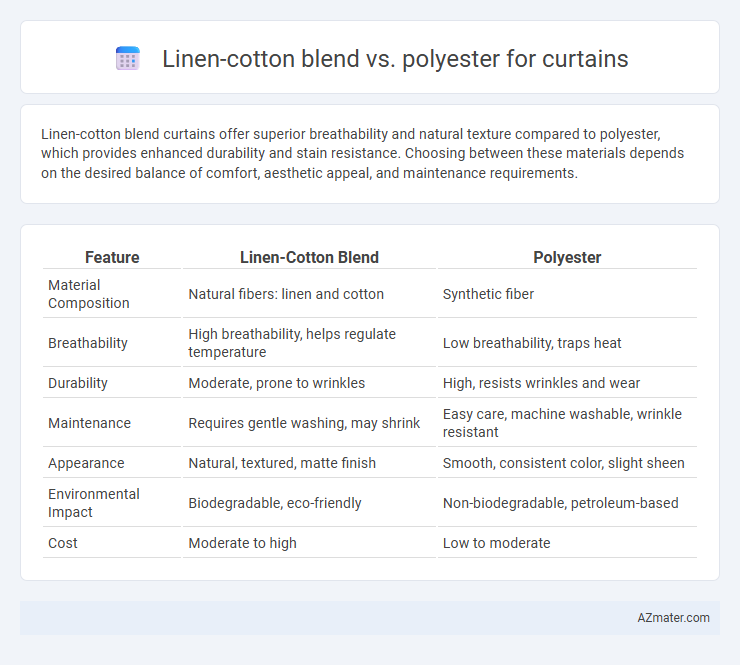Linen-cotton blend curtains offer superior breathability and natural texture compared to polyester, which provides enhanced durability and stain resistance. Choosing between these materials depends on the desired balance of comfort, aesthetic appeal, and maintenance requirements.
Table of Comparison
| Feature | Linen-Cotton Blend | Polyester |
|---|---|---|
| Material Composition | Natural fibers: linen and cotton | Synthetic fiber |
| Breathability | High breathability, helps regulate temperature | Low breathability, traps heat |
| Durability | Moderate, prone to wrinkles | High, resists wrinkles and wear |
| Maintenance | Requires gentle washing, may shrink | Easy care, machine washable, wrinkle resistant |
| Appearance | Natural, textured, matte finish | Smooth, consistent color, slight sheen |
| Environmental Impact | Biodegradable, eco-friendly | Non-biodegradable, petroleum-based |
| Cost | Moderate to high | Low to moderate |
Introduction to Curtain Fabric Choices
Linen-cotton blend curtains offer a natural, breathable fabric with a soft texture and excellent drape, making them ideal for creating a warm, inviting atmosphere. Polyester curtains provide durability, wrinkle resistance, and easy maintenance, often preferred for high-traffic areas or moisture-prone rooms. Choosing between linen-cotton blend and polyester depends on the balance between aesthetic appeal, texture, and practical performance required for the space.
Overview of Linen-Cotton Blend Curtains
Linen-cotton blend curtains combine the natural breathability and texture of linen with the softness and durability of cotton, offering a lightweight yet sturdy option for window treatments. This fabric blend provides excellent moisture-wicking properties and a subtle sheen that enhances the aesthetic appeal of any room while maintaining ease of maintenance. Its eco-friendly nature and hypoallergenic qualities make linen-cotton blend curtains an ideal choice for homeowners seeking both style and sustainability.
Overview of Polyester Curtains
Polyester curtains are popular due to their durability, wrinkle resistance, and ease of maintenance compared to linen-cotton blend options. These synthetic curtains offer excellent color retention and moisture resistance, making them ideal for various environments. Their affordability and wide range of textures and finishes provide versatile styling options for both residential and commercial spaces.
Aesthetic Appeal: Natural vs Synthetic Look
Linen-cotton blend curtains offer a natural, textured aesthetic that enhances warm and inviting interiors with their breathable, matte finish. Polyester curtains provide a smooth, consistent appearance with a slight sheen, lending a more modern and synthetic look ideal for contemporary spaces. Choosing between these materials depends on whether the preference is for organic charm or sleek durability in curtain design.
Durability and Longevity Comparison
Linen-cotton blend curtains offer moderate durability with natural fibers that are breathable and resistant to wear, but they may degrade faster under prolonged sunlight exposure compared to synthetic fabrics. Polyester curtains provide superior longevity due to their high resistance to stretching, shrinking, and fading, making them ideal for long-term use in various environmental conditions. Choosing between these materials depends on balancing the natural aesthetic and moderate durability of linen-cotton against the robust, long-lasting qualities of polyester.
Maintenance and Care Requirements
Linen-cotton blend curtains require gentle washing with mild detergents and air drying to maintain fabric integrity and prevent shrinkage, while polyester curtains are machine washable, wrinkle-resistant, and dry quickly, making them easier to maintain. The natural fibers in linen-cotton blends may be prone to discoloration and require more frequent cleaning to avoid dust accumulation, whereas polyester's synthetic composition resists stains and fading, reducing the need for intensive upkeep. Regular vacuuming and spot cleaning are recommended for both fabrics to extend curtain lifespan and preserve appearance.
Light Filtration and Privacy
Linen-cotton blend curtains offer moderate light filtration with a natural texture that softly diffuses sunlight while maintaining a degree of privacy, making them ideal for living rooms and bedrooms. Polyester curtains provide superior light-blocking capabilities and enhance privacy due to their tight weave and durable synthetic fibers, often favored for blackout or room-darkening needs. Choosing between these materials depends on balancing the desired softness and breathability of linen-cotton against the robust light control and privacy offered by polyester.
Environmental Impact and Sustainability
A linen-cotton blend offers superior environmental benefits compared to polyester, as it is derived from renewable, biodegradable natural fibers that reduce microplastic pollution. Polyester, a synthetic fabric made from petroleum, involves high energy consumption and emits significant greenhouse gases during production and disposal. Choosing linen-cotton curtains supports sustainable agriculture and lowers the carbon footprint, making them an eco-friendly alternative to polyester.
Cost Considerations and Value for Money
Linen-cotton blend curtains typically have a higher upfront cost than polyester but offer superior breathability and natural texture, enhancing long-term value through durability and aesthetic appeal. Polyester curtains, while more budget-friendly initially and resistant to wrinkles and fading, may lack the premium feel and natural fiber benefits, potentially requiring earlier replacement. Evaluating cost considerations, linen-cotton blends provide better value for money in settings prioritizing luxury and longevity, whereas polyester suits cost-conscious buyers seeking easy maintenance.
Which Curtain Fabric Is Right for You?
Linen-cotton blend curtains offer a natural, breathable fabric with a soft texture and excellent light diffusion, ideal for creating a cozy, eco-friendly ambiance. Polyester curtains provide durability, stain resistance, and easy maintenance, making them a practical choice for high-traffic areas or moisture-prone rooms. Choosing between linen-cotton blend and polyester depends on your preference for natural fibers and aesthetic versus durability and functionality in curtain fabric.

Infographic: Linen-cotton blend vs Polyester for Curtain
 azmater.com
azmater.com